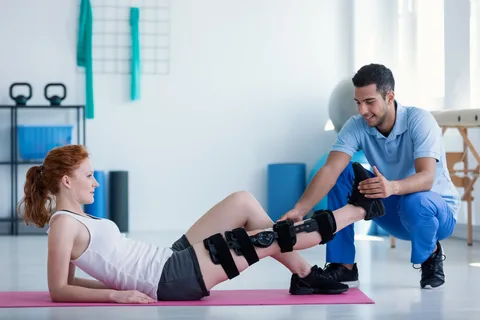Knees are remarkable joints that play a fundamental role in our daily lives. However, when knee pain strikes due to injury or chronic conditions, it can significantly impact our ability to move freely and comfortably. Physical therapy is often the key to reclaiming mobility and reducing pain during knee recovery. Advanced physical therapy strategies for knee recovery, including innovative techniques like cupping for muscle pain relief. Whether you’re recovering from knee surgery, managing knee pain, or rehabilitating a sports injury, understanding these strategies can pave the way to a healthier, pain-free life.
The Complexities of Knee Pain
Knee pain can stem from various causes, such as:
- Injuries: Injuries like anterior cruciate ligament (ACL) tears, meniscus tears, and sprains are common sources of knee pain.
- Osteoarthritis: Knee osteoarthritis, often due to age or wear and tear, can lead to chronic pain and stiffness.
- Overuse: Excessive strain on the knee joint from activities like running or repetitive motions can result in pain and discomfort.
- Muscle Imbalances: Weak or imbalanced muscles surrounding the knee can contribute to pain and instability.
- Comprehensive Assessment and Diagnosis
An accurate assessment and diagnosis are the foundation of any effective knee rehabilitation program. A skilled physical therapist will thoroughly evaluate factors like range of motion, muscle strength, joint stability, and overall function. This assessment serves as a roadmap to identify specific issues that need attention in your customized treatment plan.
- Targeted Strengthening Exercises
One of the primary goals of physical therapy for knee pain is to strengthen the muscles surrounding the knee joint. Strengthening exercises are crucial to support the joint, alleviate strain, and enhance overall function. Exercises such as leg raises, squats and resistance band workouts are commonly prescribed to achieve these goals.
- Range of Motion (ROM) Exercises
Preserving or enhancing the knee’s range of motion is vital for recovery. Physical therapists may incorporate passive and active range of motion exercises to prevent stiffness and improve flexibility.
- Pain Management Techniques
Effectively managing pain is a critical aspect of knee recovery. Physical therapists employ pain management techniques, including manual therapy, heat and cold therapy, and modalities such as TENS (transcutaneous electrical nerve stimulation). These techniques help alleviate discomfort and enhance the healing process.
- Gait Training
Learning to walk correctly and with minimal pain is crucial to knee rehabilitation. Physical therapists analyze your walking pattern and provide guidance on adjustments to ensure proper alignment and minimize stress on the knee joint.
- Cupping for Muscle Pain Relief
Cupping massage therapy, an ancient practice, has gained recognition in physical therapy for effectively relieving muscle pain. This technique involves placing cups on the skin’s surface and creating suction. Cupping therapy offers several benefits for knee recovery:
– Enhanced Blood Flow: The suction created by cupping promotes increased blood circulation to the treated area, facilitating tissue healing and reducing muscle tension.
– Muscle Relaxation: Cupping helps relax tight muscles surrounding the knee, alleviating pain and enhancing mobility.
– Fascial Release: It targets fascial adhesions, which can restrict movement and contribute to discomfort.
– Pain Reduction: Cupping therapy can alleviate pain and soreness, making it easier for patients to engage in other rehabilitation exercises.
- Neuromuscular Reeducation
After a knee injury or surgery, the brain may need to relearn how to communicate with the muscles surrounding the knee. Neuromuscular reeducation techniques help improve muscle coordination and balance, reducing the risk of reinjury.
- Home Exercise Programs
Consistency in exercise is key to achieving lasting results in knee recovery. Physical therapists provide patients personalized exercises and stretches they can perform independently between therapy sessions. Following these programs diligently enhances
- Nutrition and Hydration for Knee Recovery
Proper nutrition and hydration are crucial elements of knee recovery during physical therapy. To facilitate healing, prioritize a well-rounded diet and adequate fluid intake. Incorporate lean protein sources like chicken, fish, and legumes to aid muscle repair and recovery. Additionally, include anti-inflammatory foods such as fatty fish and fruits and vegetables rich in antioxidants to alleviate knee pain and inflammation. Conversely, limit or avoid processed foods high in sugar and sodium, as they can worsen inflammation, and steer clear of trans fats found in fried and processed snacks, which may exacerbate knee discomfort.
Hydration is equally vital for knee recovery. Maintain fluid levels by targeting at least 8 cups (64 ounces) of water daily, adjusting for your activity level and individual needs. Enhance hydration by including water-rich foods like cucumbers and watermelon in your diet. By incorporating these strategies into your knee recovery plan, you can create optimal conditions for healing, improved mobility, and pain reduction.
Conclusion
Recovery from knee pain and injuries can be challenging but ultimately rewarding. Don’t hesitate to contact them if you seek expert guidance and rehabilitation for knee recovery. Their dedicated team of skilled therapists is committed to providing comprehensive care, including innovative techniques like cupping for muscle pain relief. Experience the transformative power of physical therapy by visiting their website and scheduling your appointment today.












